Spatiotemporal Differentiation and Influencing Factors of Frost Key Date in Harbin Municipality from 1961 to 2022
Abstract
1. Introduction
2. Study Area, Data Sources, and Methods
2.1. Study Area
2.2. Data Sources
2.3. Methods
3. Results
3.1. Temporal and Spatial Variation and Mutation Test of FSD
3.2. Temporal and Spatial Change and Mutation Test of FED
3.3. Test of Spatio-Temporal Variation and Abrupt Change in FFS
3.4. Factors Influencing of Frost
4. Discussion
4.1. Trends in FSD, FED, and FFS
4.2. Testing FSD, FED, and FFS Based on Grey Relational Analysis
4.3. Study Limitations
5. Conclusions
- (1)
- The first FSD occurred on 18 August, in both 1966 and 1967, which was the 255th day. The latest FSD was observed on 10 October 2006, which was the 283rd day. The earliest occurrence of an FED was on 24 April 2015, which was the 114th day, and the latest was on 21 April 1974, which was the 141st day. The highest number of frost days occurred in 2012, with 161 days, whereas the shortest year was 1966, with only 123 frost days.
- (2)
- Throughout the study period, the FSD increased by 7.8 days at a rate of −1.27d/10a, the FED by 10.9 days at a rate of 1.77d/10a, and the FFS by 18.9 days at a rate of 3.05d/10a. The propensity rates of the FSD and FFS at each location in Harbin indicate an upward trend, while for the FED, certain locations display an upward trend. In general, the FSD has exhibited a delayed trend, the FED has shown an earlier trend, and the FFS has experienced an extended trend. With one-way linear regression, the sites exhibit an upward trend for both the FSD and FFS, and a downward trend for the FED altogether.
- (3)
- Throughout the study period, a change was observed in the FSD in 2000, resulting in an average arrival time of the 265th day, or 22 September, of that year. Subsequently, post mutation, the average arrival time of the FSD in the study area was the 272nd day, or 29 September, of that year. In 2006, the FED also underwent a change, with the average arrival time in the study area being the 128th day, or 4 April, of that year. After the change, the average arrival time of the FED in the study area was the 121st day, i.e., 8 April. April 1st of that year saw a change in the FFS in 2004. Prior to the change, the FFS in the study area averaged 137 days, whilst following the change, the FFS in the study area averaged 150 days.
- (4)
- The FSD and FFS within the Harbin area exhibit a negative correlation with latitude and a positive correlation with temperature. Additionally, the FED displays a positive correlation with latitude and a negative correlation with temperature. As the FSD, FED, and FFS in central Harbin are the earliest, latest, and longest, the Pearson correlation coefficient method and multiple regression cannot adequately capture the effect of longitude. Several factors were evaluated using the grey correlation analysis method. The longitudinal variables demonstrate a significant relationship with the FSD, FED, and FFS.
Author Contributions
Funding
Data Availability Statement
Conflicts of Interest
References
- Song, C.; Dai, C.; Wang, C.; Yu, M.; Gao, Y.; Tu, W. Characteristic Analysis of the Spatio-Temporal Distribution of Key Variables of the Soil Freeze–Thaw Processes over Heilongjiang Province, China. Water 2022, 14, 2573. [Google Scholar] [CrossRef]
- Erlat, E.; Türkeş, M. Analysis of Observed Variability and Trends in Numbers of Frost Days in Turkey for the Period 1950–2010. Int. J. Climatol. 2012, 32, 1889–1898. [Google Scholar] [CrossRef]
- Scheifinger, H.; Menzel, A.; Peter, K.C. Trends of Spring Time Frost Events and Phenological Dates in Central Europe. Theor. Appl. Climatol. 2003, 74, 41–51. [Google Scholar] [CrossRef]
- Terando, A.; Easterling, W.E.; Keller, K.; Easterling, D.R. Observed and Modeled Twentieth-Century Spatial and Temporal Patterns of Selected Agro-Climate Indices in North America. J. Clim. 2012, 25, 473–490. [Google Scholar] [CrossRef]
- Xiang, L.; Lijuan, C.; Peiqun, Z. Characteristics of Interdecadal Variations in First-Frost Date in Northern China During 1954–2005. Adv. Clim. Chang. Res. 2008, 4, 21–25. [Google Scholar]
- Masson-Delmotte, V.; Zhai, P.; Pirani, A.; Connors, S.L.; Péan, C.; Berger, S.; Caud, N.; Chen, Y.; Goldfarb, L.; Gomis, M.I.; et al. (Eds.) Climate Change 2021: The Physical Science Basis. In Contribution of Working Group I to the Sixth Assessment Report of the Intergovernmental Panel on Climate Change; Cambridge University Press: Cambridge, UK; New York, NY, USA, 2021. [Google Scholar]
- Qian, W.; Lin, X. Regional Trends in Recent Precipitation Indices in China. Meteorol. Atmos. Phys. 2005, 90, 193–207. [Google Scholar] [CrossRef]
- Zhai, P.; Sun, A.; Ren, F.; Liu, X.; Gao, B.; Zhang, Q. Changes of Climate Extremes in China. Clim. Chang. 1999, 42, 203–218. [Google Scholar] [CrossRef]
- Wang, K.; Zhang, T.; Zhong, X. Changes in the Timing and Duration of the Near-Surface Soil Freeze/Thaw Status from 1956 to 2006 across China. Cryosphere 2015, 9, 1321–1331. [Google Scholar] [CrossRef]
- Peng, X.; Frauenfeld, O.W.; Cao, B.; Wang, K.; Wang, H.; Su, H.; Huang, Z.; Yue, D.; Zhang, T. Response of Changes in Seasonal Soil Freeze/Thaw State to Climate Change from 1950 to 2010 across China. J. Geophys. Res. Earth Surf. 2016, 121, 1984–2000. [Google Scholar] [CrossRef]
- Barnett, T.P.; Adam, J.C.; Lettenmaier, D.P. Potential Impacts of a Warming Climate on Water Availability in Snow-Dominated Regions. Nature 2005, 438, 303–309. [Google Scholar] [CrossRef]
- Paudel, K.P.; Andersen, P. Response of Rangeland Vegetation to Snow Cover Dynamics in Nepal Trans Himalaya. Clim. Chang. 2013, 117, 149–162. [Google Scholar] [CrossRef]
- Aurela, M.; Laurila, T.; Tuovinen, J. The Timing of Snow Melt Controls the Annual CO2 Balance in a Subarctic Fen. Geophys. Res. Lett. 2004, 31, L16119. [Google Scholar] [CrossRef]
- Reid, D.G.; Bilodeau, F.; Krebs, C.J.; Gauthier, G.; Kenney, A.J.; Gilbert, B.S.; Leung, M.C.-Y.; Duchesne, D.; Hofer, E. Lemming Winter Habitat Choice: A Snow-Fencing Experiment. Oecologia 2012, 168, 935–946. [Google Scholar] [CrossRef] [PubMed]
- Niittynen, P.; Heikkinen, R.K.; Luoto, M. Snow Cover Is a Neglected Driver of Arctic Biodiversity Loss. Nat. Clim. Chang. 2018, 8, 997–1001. [Google Scholar] [CrossRef]
- Pulliainen, J.; Aurela, M.; Laurila, T.; Aalto, T.; Takala, M.; Salminen, M.; Kulmala, M.; Barr, A.; Heimann, M.; Lindroth, A.; et al. Early Snowmelt Significantly Enhances Boreal Springtime Carbon Uptake. Proc. Natl. Acad. Sci. USA 2017, 114, 11081–11086. [Google Scholar] [CrossRef]
- Adger, W.N.; Huq, S.; Brown, K.; Conway, D.; Hulme, M. Adaptation to Climate Change in the Developing World. Prog. Dev. Stud. 2003, 3, 179–195. [Google Scholar] [CrossRef]
- Burakowski, E.A.; Wake, C.P.; Braswell, B.; Brown, D.P. Trends in Wintertime Climate in the Northeastern United States: 1965–2005. J. Geophys. Res. Atmos. 2008, 113, D20114. [Google Scholar] [CrossRef]
- Huntington, T.G.; Richardson, A.D.; McGuire, K.J.; Hayhoe, K. Climate and Hydrological Changes in the Northeastern United States: Recent Trends and Implications for Forested and Aquatic ecosystemsThis Article Is One of a Selection of Papers from NE Forests 2100: A Synthesis of Climate Change Impacts on Forests of the Northeastern US and Eastern Canada. Can. J. For. Res. 2009, 39, 199–212. [Google Scholar] [CrossRef]
- Strain, B.R. The Effect of a Late Spring Frost on the Radial Growth of Variant Quaking Aspen Biotypes. For. Sci. 1966, 3, 334–337. [Google Scholar] [CrossRef]
- Inouye, D.W. Effects of Climate Change on Phenology, Frost Damage, and Floral Abundance of Montane Wildflowers. Ecology 2008, 89, 353–362. [Google Scholar] [CrossRef]
- Perry, E.M.; Nuttall, J.G.; Wallace, A.J.; Fitzgerald, G.J. In-Field Methods for Rapid Detection of Frost Damage in Australian Dryland Wheat during the Reproductive and Grain-Filling Phase. Crop Pasture Sci. 2017, 68, 516. [Google Scholar] [CrossRef]
- Leske, B.A.; Biddulph, T.B. Estimating Effects of Radiation Frost on Wheat Using a Field-Based Frost Control Treatment to Stop Freezing Damage. Genes 2022, 13, 578. [Google Scholar] [CrossRef]
- Fuller, M.P.; Fuller, A.M.; Kaniouras, S.; Christophers, J.; Fredericks, T. The Freezing Characteristics of Wheat at Ear Emergence. Eur. J. Agron. 2007, 26, 435–441. [Google Scholar] [CrossRef]
- Kang, S.K.; Ahn, K.H.; Choi, S.T.; Do, K.R.; Cho, K.S. Effect of Planting Site and Direction of Fruiting on Fruit Frost Damage in Persimmon (Diospyros Kaki ’Fuyu’) Fruits from Environment-Friendly Orchard. Korean J. Org. Agric. 2014, 22, 789–799. [Google Scholar] [CrossRef]
- Alharbi, N.H.; Alghamdi, S.S.; Migdadi, H.M.; El-Harty, E.H.; Adhikari, K.N. Evaluation of Frost Damage and Pod Set in Faba Bean (Vicia faba L.) under Field Conditions. Plants 2021, 10, 1925. [Google Scholar] [CrossRef] [PubMed]
- Julian, C.; Herrero, M.; Rodrigo, J. Flower Bud Drop and Pre-Blossom Frost Damage in Apricot (Prunus armeniaca L.). J. Appl. Bot. Food Qual. 2007, 81, 21–25. [Google Scholar] [CrossRef][Green Version]
- Lou, W.; Zhao, Y.; Huang, X.; Zhu, T.; Yang, M.; Deng, S.; Zhou, Z.; Zhang, Y.; Sun, Q.; Chen, S. Frost Risk Assessment Based on the Frost-Induced Injury Rate of Tea Buds: A Case Study of the Yuezhou Longjing Tea Production Area, China. Eur. J. Agron. 2023, 147, 126839. [Google Scholar] [CrossRef]
- Guillaume, C.; Isabelle, C.; Marc, B.; Thierry, A. Assessing Frost Damages Using Dynamic Models in Walnut Trees: Exposure Rather than Vulnerability Controls Frost Risks: Frost Risks in Walnut Trees. Plant Cell Environ. 2018, 41, 1008–1021. [Google Scholar] [CrossRef]
- Souther, S.; McGraw, J.B. Vulnerability of Wild American Ginseng to an Extreme Early Spring Temperature Fluctuation. Popul. Ecol. 2011, 53, 119–129. [Google Scholar] [CrossRef]
- Ma, Q.; Huang, J.; Hänninen, H.; Berninger, F. Divergent Trends in the Risk of Spring Frost Damage to Trees in Europe with Recent Warming. Glob. Chang. Biol. 2019, 25, 351–360. [Google Scholar] [CrossRef]
- Gu, L.; Hanson, P.J.; Post, W.M.; Kaiser, D.P.; Yang, B.; Nemani, R.; Pallardy, S.G.; Meyers, T. The 2007 Eastern US Spring Freeze: Increased Cold Damage in a Warming World? BioScience 2008, 58, 253–262. [Google Scholar] [CrossRef]
- Meiners, S.J.; Presley, G.N. Differential Damage of a Late Frost to Ozark Tree Species1. J. Torrey Bot. Soc. 2015, 142, 12–17. [Google Scholar] [CrossRef]
- Kurihashi, Y.; Konno, H.; Hama, Y. Effects of Frost-Damaged Reinforced Concrete Beams on Their Impact Resistance Behavior. Constr. Build. Mater. 2021, 274, 122089. [Google Scholar] [CrossRef]
- Kłos, K.; Adamczewski, G.; Woyciechowski, P.; Łukowski, P. Carbonation of concrete cover of reinforcement as a cause of loss of durability of structures. Arch. Civ. Eng. 2023, 369, 119–129. [Google Scholar] [CrossRef]
- Su, T.; Huang, Z.; Yuan, J.; Zou, Z.; Wang, C.; Yi, H. Bond Properties of Deformed Rebar in Frost-Damaged Recycled Coarse Aggregate Concrete under Repeated Loading. J. Mater. Civ. Eng. 2022, 34, 04022257. [Google Scholar] [CrossRef]
- Xu, S.; Nie, B.; Li, A. Bond Properties for Plain Bars in Frost-Damaged Concrete. Mag. Concr. Res. 2019, 71, 975–988. [Google Scholar] [CrossRef]
- Tahiri, I.; Dangla, P.; Vandamme, M.; Vu, Q.H. Numerical Investigation of Salt-Frost Damage of Pervious Concrete at the Scale of a Few Aggregates. Cem. Concr. Res. 2022, 162, 106971. [Google Scholar] [CrossRef]
- Liu, B.; Henderson, M.; Xu, M. Spatiotemporal Change in China’s Frost Days and Frost-Free Season, 1955–2000. J. Geophys. Res. Atoms. 2008, 113, D12104. [Google Scholar] [CrossRef]
- Elizbarashvili, E.S.; Elizbarashvili, M.E.; Elizbarashvili, S.E.; Kutaladze, N.B.; Gogiya, N.M. Characteristics of Frost Days in the Mountain Regions of Georgia. Russ. Meteorol. Hydrol. 2019, 44, 145–151. [Google Scholar] [CrossRef]
- García-Martín, A.; Paniagua, L.L.; Moral, F.J.; Rebollo, F.J.; Rozas, M.A. Spatiotemporal Analysis of the Frost Regime in the Iberian Peninsula in the Context of Climate Change (1975–2018). Sustainability 2021, 13, 8491. [Google Scholar] [CrossRef]
- Easterling, D.R. Recent Changes in Frost Days and the Frost-Free Season in the United States. Bull. Am. Meteor. Soc. 2002, 83, 1327–1332. [Google Scholar] [CrossRef]
- Jo, E.S.; Kim, H.-M.; Shin, J.-Y.; Kim, K.R.; Lee, Y.H.; Jee, J.-B. Characteristics and Trends of Spatiotemporal Distribution of Frost Occurrence in South Korea for 21 Years. Korean J. Agric. For. Meteorol. 2022, 24, 83–94. [Google Scholar]
- Masaki, Y. First and Last Frost Date Determinations Based on Meteorological Observations in Japan: Trend Analysis and Estimation Scheme Construction. Theor. Appl. Clim. 2021, 145, 411–426. [Google Scholar] [CrossRef]
- Fu, Q.; Zhou, Z.; Li, T.; Liu, D.; Hou, R.; Cui, S.; Yan, P. Spatiotemporal Characteristics of Droughts and Floods in Northeastern China and Their Impacts on Agriculture. Stoch. Environ. Res. Risk Assess. 2018, 32, 2913–2931. [Google Scholar] [CrossRef]
- Wu, H.; Gao, L.; Song, D.; Yang, Y.; Xu, C.; Yang, X. A Dataset of District/County-Level Population Distribution of China’s Six National Censuses. CSD 2022, 7. [Google Scholar] [CrossRef]
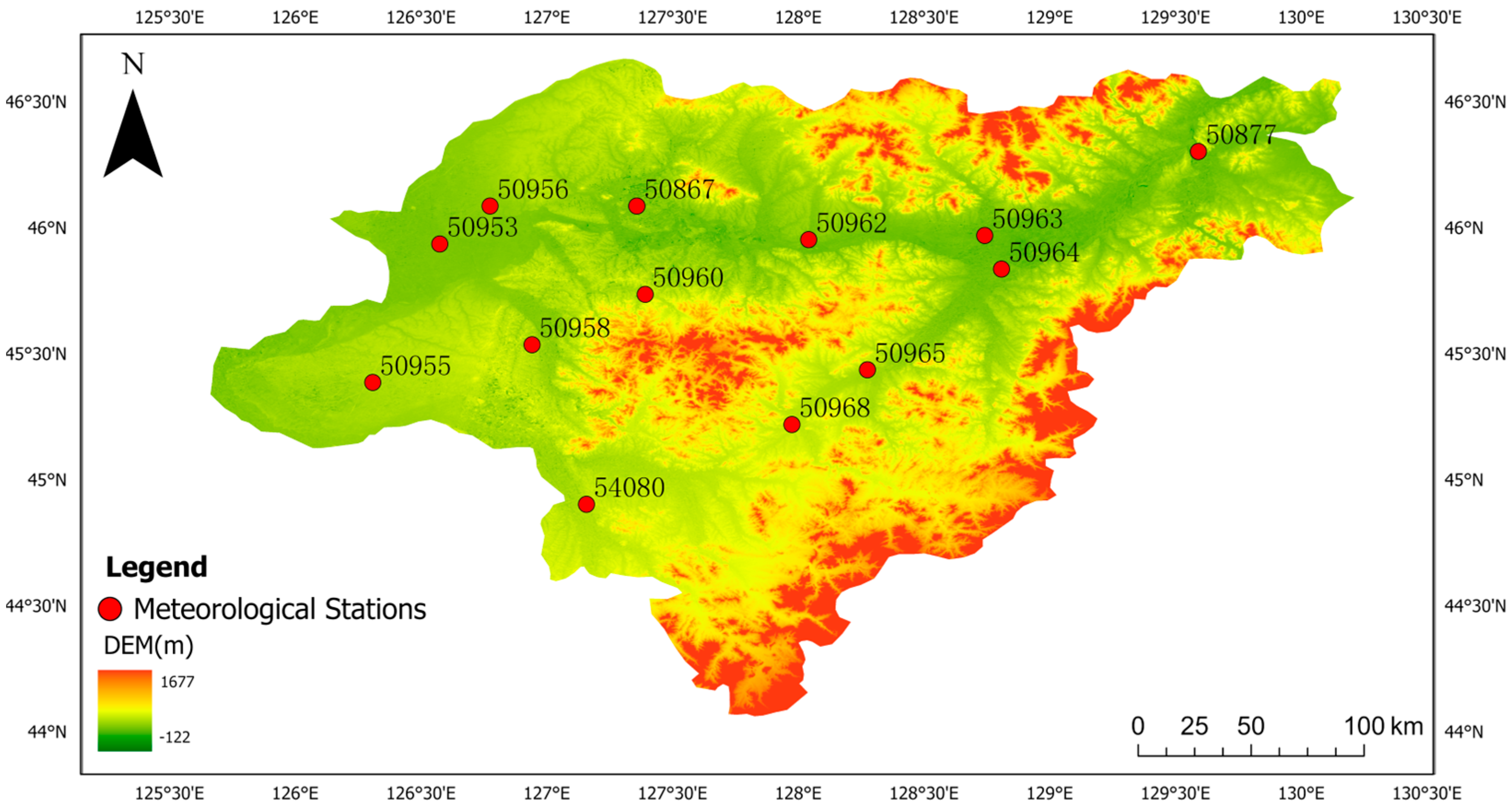

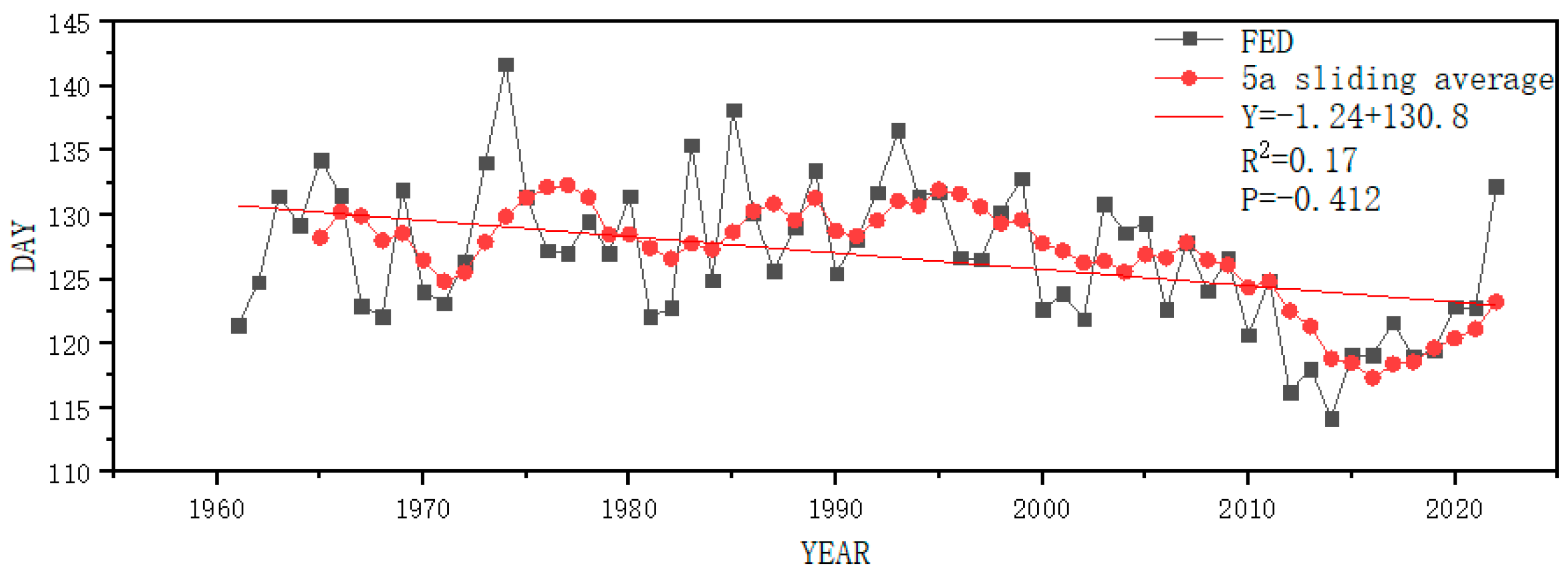
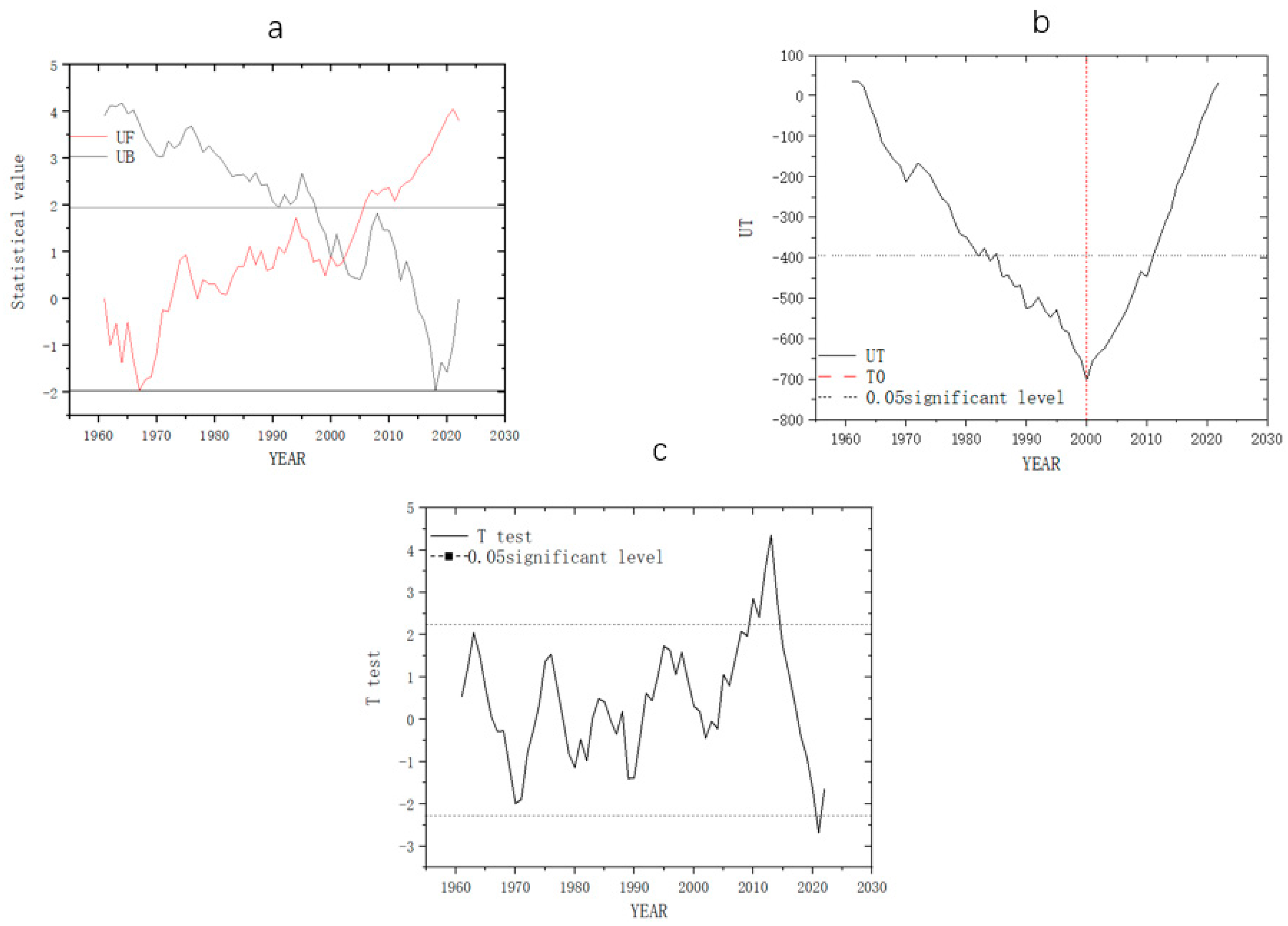
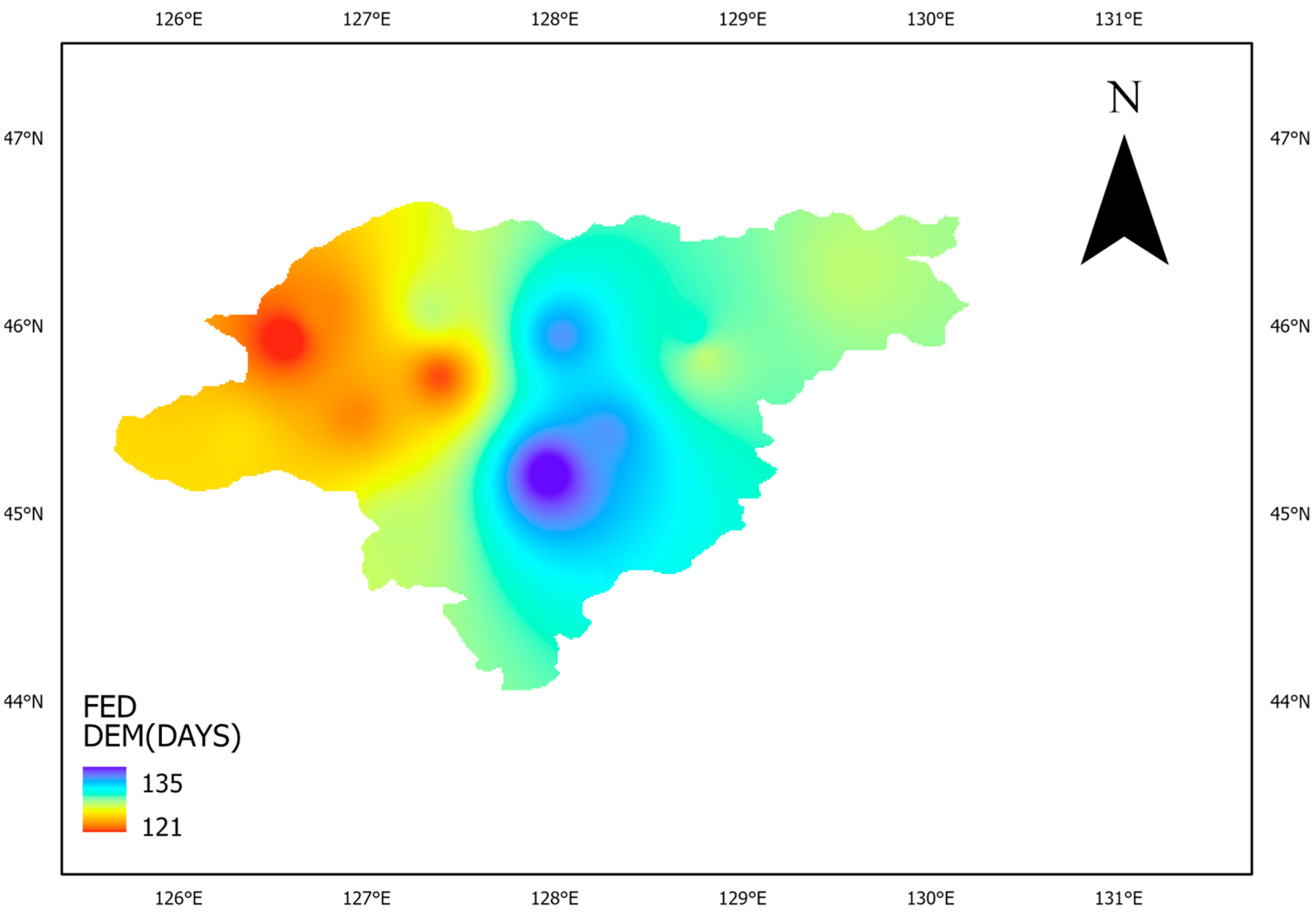


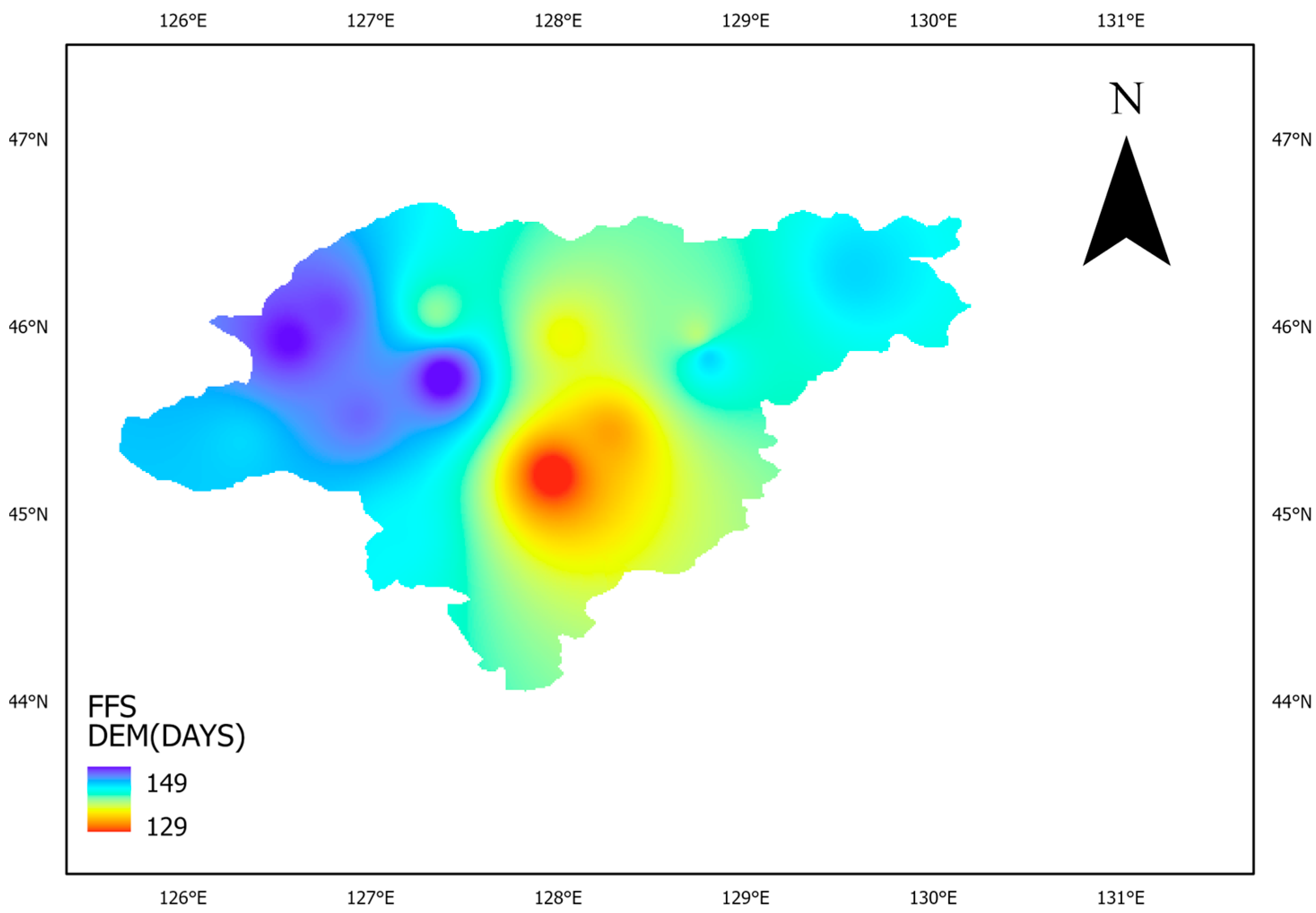
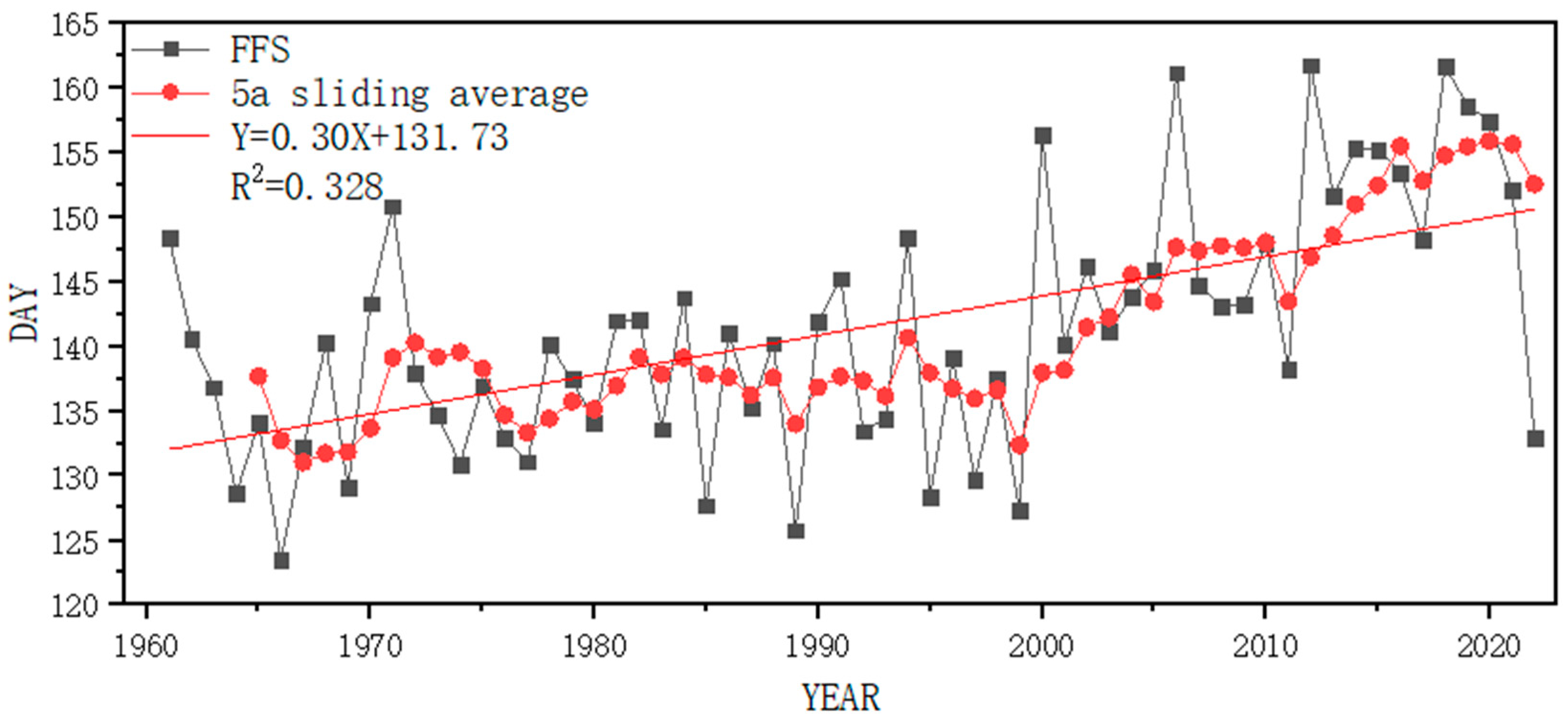
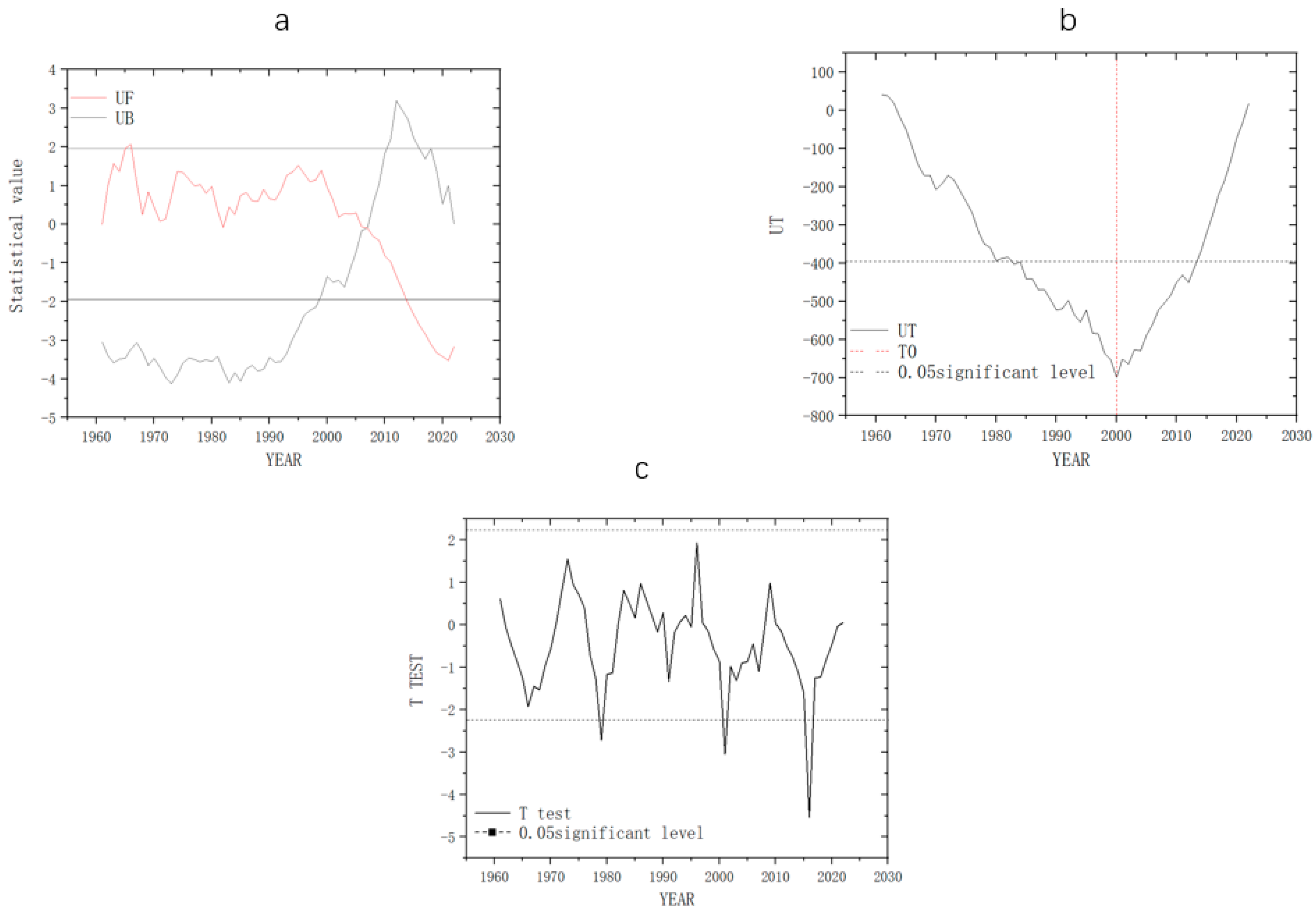
| Station | Name | Station | Name |
|---|---|---|---|
| 50867 | Bayan | 50962 | Mulan |
| 50877 | Yilan | 50963 | Tonghe |
| 50953 | Harbin | 50964 | Fangzheng |
| 50955 | Shuangcheng | 50965 | Yanshou |
| 50956 | Hulan | 50968 | Shangzhi |
| 50958 | Acheng | 54080 | Wuchang |
| 50960 | Binxian | —— | —— |
| Factor | IF | FSD | FED | FFS |
|---|---|---|---|---|
| CC | ASL | −0.05 | −0.048 | 0.016 |
| LAT | 0.523 | −0.121 | 0.165 | |
| LON | 0.147 | −0.134 | 0.145 | |
| TEMP | 0.363 | −0.614 | 0.557 | |
| POP | 0.187 | −0.514 | 0.426 | |
| RG | ASL | 0.007 | −0.028 | 0.036 |
| LAT | 1.314 | −0.4164 | 5.478 | |
| LON | −0.013 | 1.505 | −1.519 | |
| TEMP | 1.383 | −3.026 | 4.409 | |
| POP | ~0 | −0.002 | 0.002 |
| Meteorological Stations | FSD | FED | FFS | |||
|---|---|---|---|---|---|---|
| Ave. (d) | Tre. (d/10a) | Ave. (d) | Tre. (d/10a) | Ave. (d) | Tre. (d/10a) | |
| 50867 | 267 | 2.14 | 127 | −1.87 | 139 | 4.01 |
| 50877 | 269 | 2.22 | 127 | −1.64 | 143 | 3.86 |
| 50953 | 269 | 2.01 | 121 | −2.23 | 148 | 4.24 |
| 50955 | 268 | 1.64 | 125 | 0.8 | 143 | 0.84 |
| 50956 | 270 | 1.52 | 123 | 0.27 | 147 | 1.25 |
| 50958 | 268 | 1.06 | 122 | −0.21 | 146 | 1.27 |
| 50960 | 272 | 0.61 | 122 | 0.18 | 149 | 0.43 |
| 50962 | 267 | 2.09 | 132 | −2.22 | 136 | 4.31 |
| 50963 | 267 | 1.92 | 129 | −2.72 | 138 | 4.63 |
| 50964 | 270 | 1.59 | 127 | −1.48 | 143 | 3.07 |
| 50965 | 265 | 1.78 | 132 | −1.93 | 133 | 3.71 |
| 50968 | 264 | 2.91 | 135 | −2.74 | 129 | 5.65 |
| 54080 | 269 | 1.59 | 127 | −0.73 | 142 | 2.32 |
| Ave. | 268 | 1.77 | 127 | −1.27 | 141 | 3.05 |
| Factor | IF | FSD | FED | FFS |
|---|---|---|---|---|
| GCC | ASL | 0.942967 | 0.939464 | 0.951001 |
| LAT | 0.987238 | 0.975974 | 0.992901 | |
| LON | 0.988881 | 0.97644 | 0.993903 | |
| TEMP | 0.958773 | 0.971249 | 0.960265 | |
| POP | 0.848286 | 0.847311 | 0.857801 |
Disclaimer/Publisher’s Note: The statements, opinions and data contained in all publications are solely those of the individual author(s) and contributor(s) and not of MDPI and/or the editor(s). MDPI and/or the editor(s) disclaim responsibility for any injury to people or property resulting from any ideas, methods, instructions or products referred to in the content. |
© 2023 by the authors. Licensee MDPI, Basel, Switzerland. This article is an open access article distributed under the terms and conditions of the Creative Commons Attribution (CC BY) license (https://creativecommons.org/licenses/by/4.0/).
Share and Cite
Zhang, T.-T.; Dai, C.-L.; Li, S.-L.; Zhang, C.-Y.; Zhang, Y.-D.; Yu, M. Spatiotemporal Differentiation and Influencing Factors of Frost Key Date in Harbin Municipality from 1961 to 2022. Water 2023, 15, 3513. https://doi.org/10.3390/w15193513
Zhang T-T, Dai C-L, Li S-L, Zhang C-Y, Zhang Y-D, Yu M. Spatiotemporal Differentiation and Influencing Factors of Frost Key Date in Harbin Municipality from 1961 to 2022. Water. 2023; 15(19):3513. https://doi.org/10.3390/w15193513
Chicago/Turabian StyleZhang, Tian-Tai, Chang-Lei Dai, Shu-Ling Li, Chen-Yao Zhang, Yi-Ding Zhang, and Miao Yu. 2023. "Spatiotemporal Differentiation and Influencing Factors of Frost Key Date in Harbin Municipality from 1961 to 2022" Water 15, no. 19: 3513. https://doi.org/10.3390/w15193513
APA StyleZhang, T.-T., Dai, C.-L., Li, S.-L., Zhang, C.-Y., Zhang, Y.-D., & Yu, M. (2023). Spatiotemporal Differentiation and Influencing Factors of Frost Key Date in Harbin Municipality from 1961 to 2022. Water, 15(19), 3513. https://doi.org/10.3390/w15193513







